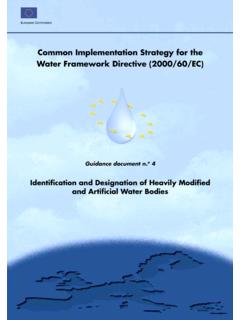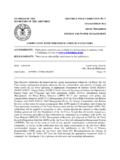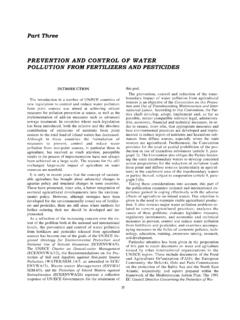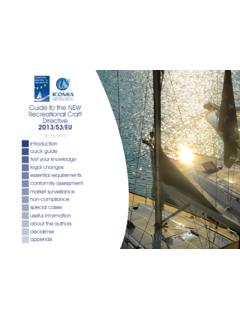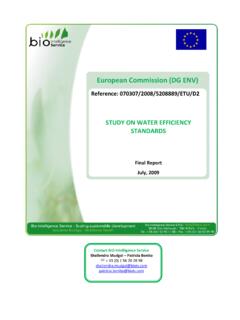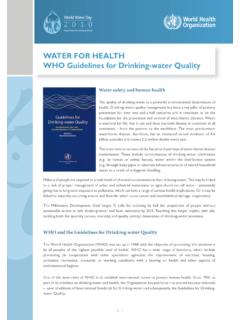Transcription of Water Quality and Agriculture: Meeting the Policy …
1 Water Quality and Agriculture: Meeting the Policy ChallengeKey Messages and Executive Summary ORGANISATION FOR ECONOMIC CO-OPERATION AND DEVELOPMENT Directorate for Trade and agriculture This document and any map included herein are without prejudice to the status of or sovereignty over any territory, to the delimitation of international frontiers and boundaries and to the name of any territory, city or area. The report is published on the responsibility of the Secretary-General of the OECD, and does not necessarily reflect the views of the OECD or its member countries. OECD 2012 Applications for permission to reproduce or translate all or part of this material should be made to: OECD Publishing, or by fax: +33 1 45 24 99 30.
2 Water Quality and agriculture : Meeting the Policy Challenge Key Messages Executive Summary Background Reports Background reports supporting the 2012 OECD study, Water Quality and agriculture : Meeting the Policy Challenge, are listed below. They are available, along with the main report, at : New and Emerging Water Pollutants arising from agriculture Alistair Boxall, Environment Department, University of York, United Kingdom agriculture s Impact on Aquaculture: Hypoxia and Eutrophication in Marine Waters Robert D az, Institute of Marine Sciences, United States Nancy N. Rabalais, Louisana Universites Marine Consortium, United States and Denise L.
3 Breitburg, Smithsonian Environmental Research Center, United States (This paper has also been published in OECD (2010), Advancing the Aquaculture Agenda: Workshop Proceedings.) agriculture and Water Quality : Monetary Costs and Benefits across OECD Countries Andrew Moxey, Pareto Consulting, Edinburgh, Scotland, United Kingdom, assisted by Eva Panagiotopoulou, Department of Agricultural Economics and Rural Development, Agricultural University of Athens, Greece Water Quality Trading in agriculture James Shortle, Environmental and Natural Resources Institute, Penn State University, United States. 5 Table of Contents of Water Quality and agriculture : Meeting the Policy Challenge Chapter 1 LINKING POLICIES, FARM MANAGEMENT AND Water Quality The challenge The Polluter-Pays-Principle The Policy mix and interactions affecting Water Quality in agriculture Farm management practices and hydrological properties and processes challenges in the interaction between farm management practices and Water Quality Bibliography Chapter 2 agriculture AND Water Quality .
4 SOURCES, TRENDS, OUTLOOK AND MONITORING Sources of Water pollution from agriculture The contribution of agriculture as a source of Water pollution Overall trends of the impacts of agriculture on Water Quality Medium-term outlook and implications of climate change Issues related to monitoring Water Quality in agriculture important for Policy makers Notes Bibliography Chapter 3 MONETARY COSTS AND BENEFITS OF agriculture S IMPACT ON Water SYSTEMS Key components in measuring the costs and benefits of agriculture on Water Quality Information needs to provide monetary cost and benefit estimates A survey of OECD countries impact estimates Further research Note
5 Bibliography Chapter4 OECD Policy INSTRUMENTS AND MIXES ADDRESSING Water Quality ISSUES IN agriculture Economic instruments Environmental regulations Information instruments and other persuasive approaches to address Water pollution Notes Bibliography 6 Chapter 5 OECD Policy EXPERIENCES IN ADDRESSING Water Quality ISSUES IN agriculture Addressing nitrate Water pollution from agriculture in the European Union Lowering pollution of the Chesapeake Bay, United States: The role of agriculture Reducing salinity in agriculture to improve Water Quality : The case of Australia Implementing Water Quality trading for nitrogen pollution in Lake Taupo, New Zealand Improving research on diffuse source Water pollution: France and the United Kingdom Reforming governance to address social concerns with Water Quality in New Zealand Addressing transborder pollution.
6 The Baltic Sea, eutrophication and agriculture Establishing co-operative agreements to address diffuse source pollution Notes Bibliography Chapter 6 MOVING TOWARDS SUSTAINABLE Water Quality MANAGEMENT IN agriculture Policy challenges Policy responses Policy reforms Policy governance and institutions Note Bibliography Tables Table The development of environmental conditionality in the EU s Common Agricultural Policy Table Sources of Water pollution from agricultural activities Table National costs of Water pollution (not necessarily all due to agriculture ) Table Overview of Policy instruments addressing diffuse sources of Water pollution Table Agri-environmental payments to address Water Quality in OECD member countries: 2008 Table Regulatory requirements for pig and dairy cow manure management in selected OECD countries Table Information instruments and other persuasive approaches to address Water pollution from agriculture Table United Kingdom Water bodies at risk of failing to meet good ecological status in 2015 (%) Table United Kingdom Water Quality costs as a result of agricultural Water pollution.
7 2007 Table Country loads and targets under the Baltic Sea Action Plan 2007 Table Comparison of the key features between co-operative agreements and environmental regulations, pollution taxes and agri-environmental payments 7 Figures Figure Linkages between policies, agriculture driving forces and the state and impact on Water Quality Figure Trends in total support and the composition of support Figure OECD: Changes in the level and composition of producer support Figure Trends in the United States Agri-environmental Conservation Payments: 1985-2012 Figure Evolution of Australian national Natural Resource Management policies Figure Nutrients in Water : a schematic diagram of pathways from agricultural use Figure Pesticides in Water : a schematic diagram of pathways from agricultural use Figure Comparison of the relative contribution of major sources of nitrogen pollution in three US coastal ecosystems experiencing hypoxia Figure OECD projections for international commodity prices in real terms to 2019 Figure Index of net agricultural production trends for selected OECD countries, 1992-2019 (Index 2004-06 = 100) Figure Water Quality Trading Programmes.
8 Canada, New Zealand and the United States Figure The European Union Water Framework Directive delivery timeline 9 KEY MESSAGES The key challenges for Policy makers in addressing Water Quality issues in agriculture are to reduce farm contaminant lost into Water systems while encourage agriculture to generate or conserve a range of benefits associated with Water systems ( recreational use). Water pollutants from agriculture include runoff and leaching into Water systems from nutrients, pesticides, soil sediments, and other contaminants ( veterinary products). The impact of agriculture on Water Quality is either stable or deteriorating, with few cases where significant improvements are reported across OECD from the mid-2000s to 2010.
9 While the current situation varies within and across OECD countries, agriculture is often the main source of Water pollution. Achieving further reductions is a challenge for Policy makers, especially as a major part of agricultural Water pollution is from diffuse sources. The overall economic, environmental and social costs of Water pollution caused by agriculture across OECD countries are likely to exceed billions of dollars annually. No satisfactory estimate of these costs exists, but the scale of damage to Water as a result of agriculture needs to be placed in perspective. For most countries drinking Water Quality is high with limited health risks and agriculture is only one source of pollution.
10 The outlook over the next ten years for agriculture and Water Quality suggests that the growth and intensification of agricultural production could further heighten regional pressures on Water systems in some countries. Moreover, the task of achieving Water Quality objectives in agriculture will become more difficult as a result of climate change. Over many years policies to address agricultural Water pollution across OECD countries have cost taxpayers billions of dollars annually. Policy responses have typically used a mix of economic incentives (taxes and subsidies), environmental regulations (prohibition and specific rules backed by penalties) and farm advice and education (information), but this has had mixed results in lowering agricultural pressure on Water systems.










